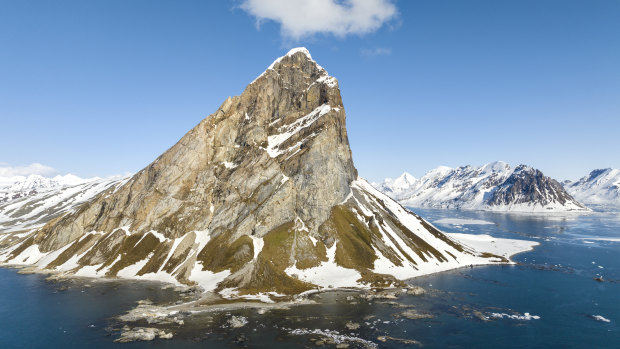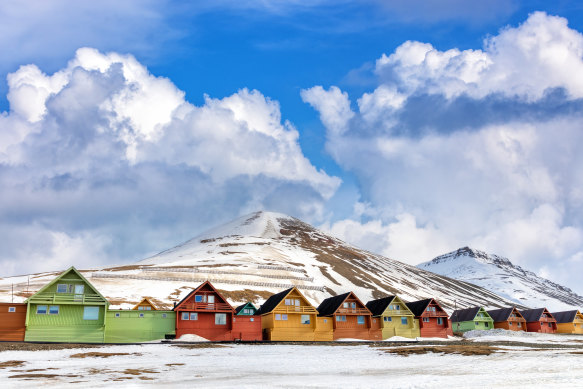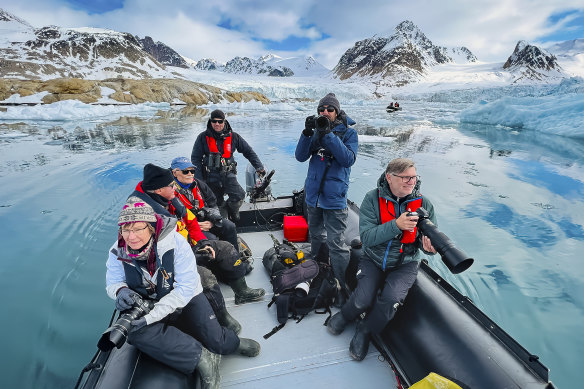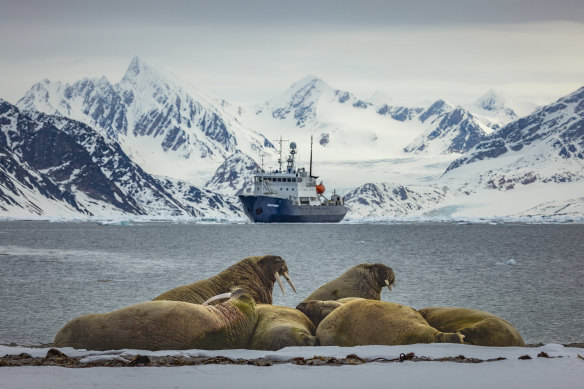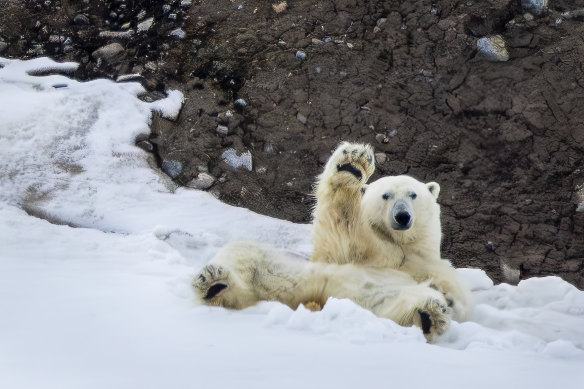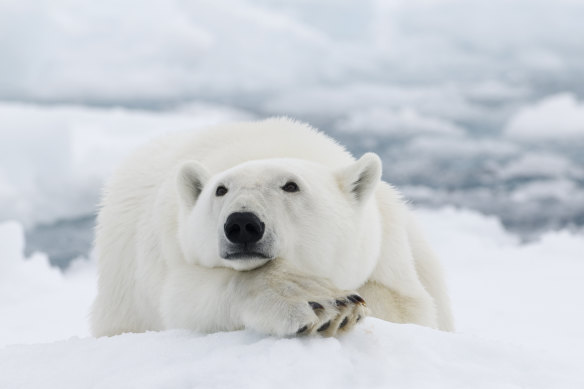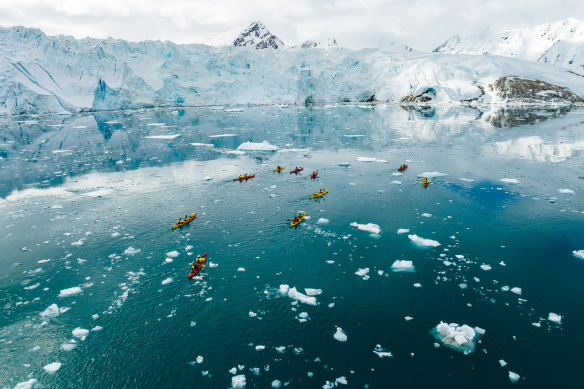
Save articles for later
Add articles to your saved list and come back to them any time.
In Svalbard’s only town, Longyearbyen, the world’s most northern, it’s a crime to leave without a loaded weapon. There are, after all, more polar bears (3000) here in summer than people (2500), making this Norwegian archipelago between mainland Norway and the North Pole one of the polar bear capitals of the world.
I have come to one of the world’s best-preserved wilderness areas to encounter a polar bear (while they still exist in the wild). Though, as I discover, so much more awaits me in this spectacular place.
Svalbard might be the most beautiful place on Earth, but its environment and wildlife are under threat.Credit: Paul Hoelen
Now listed as “vulnerable”, polar bear numbers have reduced drastically because polar bears rely on sea ice to feed on the seals that are the primary source of their diet.
While governments meet in fruitless attempts to keep the average yearly temperature rise of the planet below two degrees, here in the Arctic average temperatures have risen 5.6 degrees in the past 30 years, melting the sea ice polar bears rely on to feed and breed.
There are no towns beyond Longyearbyen – nor are there any roads – so the only way to see Svalbard is by boat.
However, the Tasmanian-based adventure travel company, Southern Sea Ventures, offer adventurous travellers a way to tread a little further with less intrusion into polar bear territory in the form of sea-kayaking expeditions aboard a former scientific research vessel, the Polar Pioneer, with room for a maximum of 50 guests.
Longyearbyen, the world’s northernmost town.Credit: iStock
Because it departs well before the peak of summer cruising when there’s more pack ice around, we stand a much better chance of seeing bears. Southern Sea Ventures’ 10-day, nine-night program can’t be pre-planned; it relies instead on daily pack ice conditions, tracked through evolving satellite images.
The balancing act in these parts of the Arctic is taking travellers as deep as possible into this wilderness without getting trapped. For the North Pole is barely 1000 kilometres north of Svalbard, and there’s no land between.
From here I’m off to explore an uninhabited wilderness three-quarters covered in ice and snow – for a glimpse of a creature that may one day be climate change’s most evocative casualty.
Of whales, walruses and Arctic foxes
We’re not long out of Longyearbyen when I’m handed a dry suit to wear in my kayak. “We dress for the possibility of being in the water at all times,” kayak lead guide and Southern Sea Ventures owner Toby Story says.
In these water temperatures – approximately zero degrees – we’d survive about 12 minutes without one. Polar bears are what concern us most on land, but on the water it’s walruses we should be scared of.
“Walruses can be three metres long, weigh two tonnes and hold their breath for 40 minutes, so you never know where they’re going to come up,” Story warns.
But with the sun shining, the water looks as welcoming as the Pacific. I’m ensconced here on the front deck below kilometre-high mountains and 500-metre-deep glaciers all the way to the horizon.
But there’s a fragility to this vastness: should the sun feel this good on my face? In the years since 1979, sea ice has shrunk 13 per cent each decade and each year we lose an area almost the size of England.
Into the ice with Svalbard Southern Sea Ventures Sea Kayak Tour.
Below us, the sea’s full of what’s known as “bergy bits” (the remnants of icebergs up to the size of small houses) and growlers (ice under a metre tall and five metres wide).
We’re on a course west through Isfjorden to the Greenland Sea, where we’ll hug the coast north till we reach Spitsbergen’s remote north-west coastline. There – if the sea ice permits – we have the best chance of finding bears along the edge of the shifting ice pack.
But the ship’s crew have been on the lookout since we left Longyearbyen. They comb the landscape with binoculars from the bridge above. Should they find a bear, they’ll wake us no matter the hour.
From late April to late August, the sun won’t set in Svalbard: so it’s likely I won’t be sleeping. The trade-off is that sightseeing is available 24/7. A pod of 20-or-so curious beluga whales appears on my starboard side at midnight, beside a solitary humpback.
Walruses can be three metres long, weigh two tonnes and hold their breath for 40 minutes.Credit: Paul Hoelen
There were once so many whales here that ship captains in the 17th century wrote of precarious sea journeys ploughing their way through whale-choked waters.
I manage a few hours of sleep and wake to find we’re anchored at the end of 14 July Bay, below a glacier. The sun feels the same as it did at 2am.
I climb down a ladder to a kayak for my first paddle. It’s the dead silence I notice when I leave the ship. There’s no noise but the brush of my paddle in the water.
Then I notice the nuances: growlers that crackle and pop as I pass by; the calving of a bergy bit or glacier and the splash that follows; and the call of kittiwakes, guillemots and puffins existing in isolation out here on sheer cliffs by the water’s edge.
A curious Arctic fox comes close to the water but there are no seals, rendering the sighting of polar bears unlikely.
Ice, ice, everywhere from here to the Pole
The captain decides that despite a poor forecast, we’ll leave the calm of the fjords for the Greenland Sea, to push further north to the top of Spitsbergen. We don’t see a single boat along the way.
Even during peak season, less than 20 operators cruise these waters and all but one carry small passenger loads.
We leave the world’s northernmost settlement behind, Ny-Alesund, a former mining town transformed into one of Europe’s most significant Arctic research stations. There’s nothing left between us and the North Pole but ice.
Some of the first attempts at reaching the North Pole originated along this coast. The most ambitious of all was Swedish engineer Salomon Andree, who set out in a hydrogen balloon in 1897.
He crashed 300 kilometres north of the coastline, but survived for three months after clawing his way back to Svalbard. His body was recovered near here, 33 years later.
We reach the north coast and see that pack ice has drifted south from the Pole. The captain sails out into the Arctic Ocean, and we gather on the bow to watch the ship separate the ice into two below us.
“And suddenly it’s there, and appears to wave at us”.Credit: Paul Hoelen
All are on the look out for bears, but we see only walruses, a polar bear’s less preferred food source.
We reach 81 degrees north, 900 kilometres south of the North Pole, and settle for the night, parked on pack ice. I stay on deck until 3am looking for bears and Greenland sharks, which can live up to 500 years.
Nowhere has felt this foreign
The ship’s all mine. Behind me are the pyramid peaks of Svalbard, beyond me is the top of the world. Nowhere in my travels has felt this foreign. Still, there are no bears.
I wake, trapped in ice. During the early hours, pack ice shifted between the ship and land, and the captain has commandeered a drone to look for the safest passage back to Svalbard.
But the Polar Pioneer pushes through; built for Russian scientific research, it’s been refurbished for travellers. It’s rough enough around the edges to feel like I’m actually here for science.
We stop in the middle of the pack ice and launch kayaks. I paddle between huge ice floes hearing the ice breathe and watching for shooters (ice that shoots back to the surface after submerging) and angry walruses.
There’s a bearded seal ahead of us: a polar bear can survive comfortably on a single bearded seal for a month, but no bear lies in wait for this one.
When we reach Spitsbergen’s north coast we anchor beside a long abandoned whaling settlement, Smeerenburgfjorden. The English and Dutch set up shore stations here to boil whale blubber down to oil to light the streets of Europe.
By the end of the 1600s, there were more than 300 whaling vessels operating off Svalbard. There’s a huddle of 20-or-so walruses on the shore beside the skeletons of what was Smeerenburgfjorden.
With their metre-long tusks, walruses can puncture kayaks, and there are two swimming in the water nearby. We turn quickly, and make a quiet retreat to the ship. Every splash I hear along the way is a would-be attack by a walrus.
Back on board, my hands shake holding a glass of beer: the adrenalin takes half an hour to dissipate. What must it feel like to come face-to-face with a polar bear?
The most beautiful place on Earth
Cute, but deadly. Polar bears have been known to hunt humans when hungry.Credit: iStock
Polar bears are the most dangerous of bears because, one, they’re carnivores and, two, hungry bears do attack and eat humans (whereas a grizzly bear is predominantly a herbivore).
In 2011 a polar bear killed 11-year-old school boy Horatio Chapple on a school excursion in Svalbard. In 2020, a tourist was killed just outside Longyearbyen; while earlier this year a mother and her child were mauled to death outside their school in Alaska.
Almost 90 per cent of all deaths have been recorded since 2000; polar bears are getting hungrier each year.
We feel much safer since our guides have high-powered rifles they carry across their shoulders on every excursion, and are expert at looking for bear signs, though, to be honest, it’s helping little so far.
With the northern seas blocked with pack ice, the captain elects to travel overnight to the south of Spitsbergen. The vastness of the north-west coast is replaced by the grandeur of these southern fjords.
Here are towering pyramid rocks home to 100,000 kittiwake nests, where Spitsbergen’s highest mountains rise straight out of mirrored blue water. This could be the most beautiful place on Earth, and yet we share it with a solitary yacht. Even it – with its two passengers – feels an intrusion.
We anchor by the mouth of Bellsund Fjord, but sea ice drifts in, and blocks our way. There are huts built by early fur trappers, including the first woman trapper, Wanny Voldstad, a widowed mother who spent five years here laying traps for Arctic foxes and polar bears, only to return home to Norway to be killed by a bus.
As we motor further up the fjord, I make out two cream-coloured figures in the snow through my binoculars. I yell “bear”, and fellow passengers run to my position on the front deck. But the cream figures are Svalbard reindeer: a subspecies of reindeer with stocky legs and short snouts.
We scan the ice and the shore for bears until I can’t look anymore. That night, I have a vivid dream: a polar bear is dancing below us on an ice floe as the ship sails past and I shout “elephant”.
Best you see it now
Sea kayaking through frigid waters amid floating “bergy bits”.Credit: Daniela Tommasi
It’s snowing when I wake, little star-shaped flakes that melt on my upturned face. We’ve taken shelter from winds blowing across the Greenland Sea, in Kongsfjorden. The snow stops and we steam to a bay set below two glaciers, Kongsvegen and Kronebreen.
We see the first fast ice of the expedition – it’s sea ice which fastens to coastline, and it’s where bears like to hunt. The stoic veteran polar bear expert Gary Miller looks mildly excited. “Could be bears,” he says to no one in particular on the front deck.
Kayakers get to choose between kayak tours or Zodiac expeditions each day. I opt for the latter for the first time: I figure I’ll see more. We move towards the fast ice and I spot a ringed seal lying on a bergy bit.
A polar bear requires at least one ringed seal a week; it waits till the seal surfaces from the water and pulls it onto land or ice, then it peels the skin off like a banana. I study the fast ice around the seal for a big, buttery coat.
Alas, nothing. We move on, motoring further down the shoreline, searching, always searching. But something’s happened behind us. One of the Zodiacs has stopped. And I see arms on-board outstretched, pointing.
Our guide kicks his outboard into higher gear and we rush off towards them. I train my binoculars at where their eyes are looking. Then I spot it. Finally.
An enormous white bear is rolling playfully on the shore by the sea ice. Its head is raised towards us. Can it be waving? It looks like it’s waving? One huge paw is extended, rotating slowly.
It waves for a minute or so. Then slouches on its back, arms back down on the snow. Then it lifts a leg, then places it back on the ground. Then another. And another. And another. I stare, and I stare. It stops, and lies back on the earth, and doesn’t move again. I’m not sure how to feel: whether to laugh, or to cry.
Everything on an Arctic trip is delivered with a degree of melancholy since all the beauty we see comes with a disclaimer: best you see it now. Polar bears are getting hungrier every year.
When did this one last eat? And how long will it last out here among this melting ice and snow? But for now – with an idiot grin frozen on my face that won’t wipe off until I go to sleep – I’ll savour this moment forever.
The writer travelled as a guest of Southern Sea Ventures.
Five other polar bears habitats
Churchill, Canada
The other polar bear capital of the world, Churchill offers the cheapest ways to see a bear – on a tundra buggy tour. Bears often roam its streets. Take a two-hour flight from Winnipeg.
Kaktovik, Alaska
It’s not easy to get here. Fly for five hours from Anchorage, or from Fairbanks, but you’ll see lots of polar bears on an indigenous-run boat tour in this tiny Eskimo village.
Nunavut, Canada
Should Churchill not be enough for you, take a 50-minute flight to this small indigenous settlement on the edge of the sea-ice pack to see bears in the wild with local Inuits.
Greenland
Greenland is home to one of the largest populations of polar bears on Earth. But they live in Greenland’s most inaccessible north-east and north-west regions – so take an expedition ship.
Wrangel Island, Russia
Some time in the future, travel to Russia’s remote Arctic where you’ll get to experience a polar bear nursery. Wrangel Island is a refuge for all bears in the area in summer.
THE DETAILS
TOUR
Southern Sea Ventures offer a 10-day, nine-night expedition aboard the Polar Pioneer from June 7 next year from $US7650, including all meals and hotel the night before the expedition begins, airfares excluded. Optional sea-kayaking supplements are $US950. They also offer expeditions to Greenland, see southernseaventures.com
FLY
Fly to Oslo in Norway with Qantas (qantas.com), with connections from London and then connect to Longyearbyen in Svalbard with SAS (flysas.com) or Norwegian (norwegian.com).
MORE
visitsvalbard.com
Get exclusive travel deals delivered straight to your inbox. Sign up now.
Most viewed on Traveller
From our partners
Source: Read Full Article
